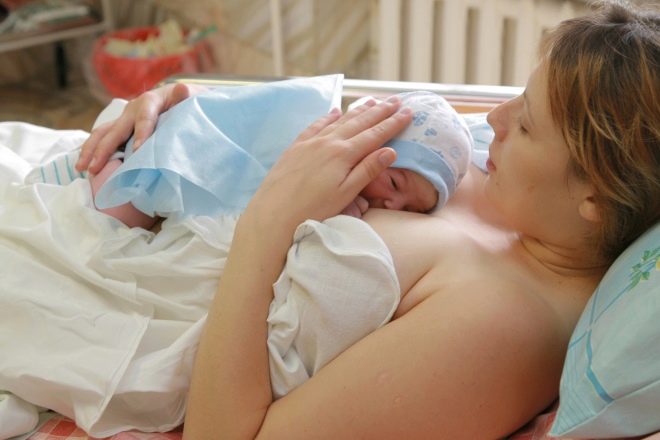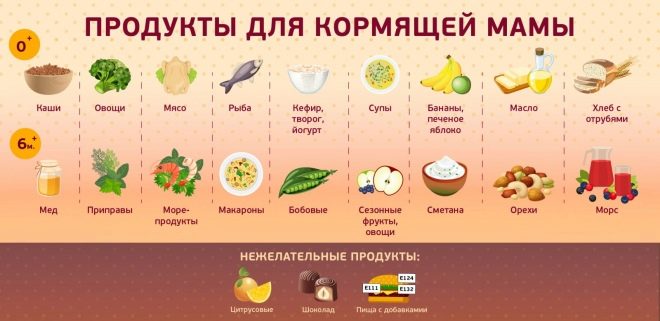What can you eat after giving birth?
Certain restrictions on nutrition during pregnancy are quite natural, because the child must receive a maximum of useful substances. But even after the baby is born, it is necessary to eat properly, and the requirements for the mother’s diet are even more stringent than when carrying the fetus, because now the baby with breast milk gets what the mother eats. We will tell about what you can eat after giving birth and how to organize your own food for a woman in this article.
Special features
The female body needs to recover after giving birth, and this is a very complex and energy-intensive process. That is why nutrition is of particular importance in matters of rehabilitation. It is no secret that the work of the intestine is often disturbed in puerperal organs, constipation begins. And the inevitable blood loss can lead to the development of anemia. To cope with such problems will help properly compiled and selected nutrition.
Approximately 2-3 days after birth, the woman begins to produce high-grade breast milk, which differs from colostrum and primary milk. From this moment on, the health of the child begins to depend directly on what the nursing mother eats, since all the useful (and harmful) substances from the woman’s food get into the composition of breast milk.
The diet should be varied, but gentle and careful, beneficially affecting the process of postnatal rehabilitation in women, as well as the health and condition of the baby.
Births can take place in a natural way, and can be surgical (cesarean section). After the first and second birth, the principles of nutrition will be different from each other, but there are only three basic principles that apply to all parturient women and puerperas:
- safety and hypoallergenic;
- variety and balance;
- correct drinking regime.
It should be understood that safe nutrition means a neutral food, without allergens, dyes, taste stabilizers, flavors and preservatives.
All these substances quickly penetrate into the composition of breast milk and can cause irreparable harm to the health of the child. Also dangerous include products that can cause fermentation of intestinal gases in both the mother and the baby, whose digestive system is not yet stabilized.
Diversity means that a woman should receive as many different nutrients as possible, vitamins, minerals, essential elements with food. It is impossible to allow "distortions" and to include in the composition of the ration the permitted product, but with a large mass advantage. For example, there is only dairy products or only meat. With each meal, a woman and a child should receive both fats, and proteins, and carbohydrates.
Drinking regimen implies a fairly large amount of fluid, especially during the first two days. To prevent excessive lactation, from the third day the amount of liquid is reduced to 0.8 liters per day from the originally recommended one and a half liters.
Proper drinking will contribute to a more rapid recovery of the female body, weight loss after childbirth, as well as the establishment of lactation.
Nutrition after physiological generic process
Natural childbirth can proceed according to the classical scheme and with complications, and this factor is decisive in determining the diet after the birth of a baby.If a woman gave birth hard, she was given an episiotomy or spontaneous ruptures of the perineum, cervix, genital tract occurred, then food is planned taking into account the ban on attempts after delivery. A woman shouldn’t be too hard to avoid damaging the stitches, and then her diet should contain dishes that will not lead to constipation, for example, liquid and semi-liquid cereals, mashed potatoes. Food should not be thick.
Even after uncomplicated births, the woman does not recommend eating foods that increase the gas formation process in the intestines; coarse fiber, raw vegetables and fruits, is also undesirable. They should be excluded from the diet during the first week after the birth of the baby.
Fatty foods and an abundance of protein foods can increase the fat content of milk, which is fraught with digestive disorders in a child due to physiological age-related enzyme deficiency.
In the first three days after giving birth, a woman is shown food that has undergone heat treatment - cereals, mashed potatoes, soups, baked apples, pears, lean meats, fish, cottage cheese, milk. The gradual introduction of raw vegetables and fruits is the task of the near future, usually they are allowed to be administered limitedly at the end of the first month after delivery.
Food should be steamed, boiled, baked. Fried, spicy, salty, spices, large amounts of sugar are contraindicated for a woman.
All these requirements correspond to the food that is prepared for the puerperal in the hospital. To minimize the risks of undesirable consequences, it is important to consider individual allergic reactions, as well as existing allergic reactions of the father of the child. This is important because Even a woman may have an allergy to an approved product, and the child is more likely to inherit an allergy from the parents, the mother and father.
If the newly-made dad is allergic to a certain product, there are risks that the child will show the same negative reaction, even if the mother does not have an allergy to this product.
When breastfeeding a young mother it is very important to eat small amounts, but often - about 6 times a day. This will not only help to establish normal lactation and improve the quality of breast milk, but also to stabilize the metabolism in the female body, so that those extra pounds gained during pregnancy will go much faster.
Each new product in the first and second months after delivery, as well as later, is introduced with caution, starting with a small amount. During the day, assess whether there is a change in the condition of the child. If the crumb continues to eat with appetite, is not covered with a rash, then in a day you can gradually increase the amount of this product in the diet. If a baby has anxiety, a stomach ache, loose stools appear, sleep is disturbed, dermatological rashes appear, the product is refused and the doctor is asked to prescribe allergy medications to help the little one get rid of the developed sensitization.
It is important not to introduce more than one new product at the same time, otherwise it will be very difficult to understand what exactly the allergic reaction develops in the child.
After natural childbirth, if a woman does not breastfeed for some reason, it is important to follow a gentle diet for the first week in order to allow the intestine to restore its function. Then a woman can eat what she likes, what she wants, with little or no restrictions. The main thing - to prevent constipation and diarrhea.
What to eat after cesarean section?
It is most seriously recommended to treat the issues of catering for women who have undergone a cesarean section. Surgical labor is associated with penetration into the abdominal cavity, and therefore the recovery is longer, moreover, for several days, the effect on the body of the means, which were administered as anesthesia, remains.
The first day after surgery, a woman is advised not to eat, because the full intestine can lead to pressure on the uterus, and its walls were dissected and sutured during the operation. Without such pressure, the reduction of the reproductive organ is faster. Straining is also contraindicated, so it is important not to allow constipation.
The first day is allowed to drink. But there is a quantitative limitation - no more than one and a half liters of pure water to prevent postoperative edema. You can add a couple of drops of lemon juice to the water.
By the end of the first day after operative labor, a woman is allowed to eat secondary beef or chicken broth. Secondary means that the meat is cooked in two waters. The one that will be the second, and will be the right broth, no different concentration. Broth can be salted, but in very small quantities.
Allowed to the end of the second day with homemade white bread crumbs, without salt and other spices, along with the broth.
By the second day, it is allowed to eat mashed potatoes without butter, moderately sweet tea and diluted fruit drinks or fruit drinks. You can eat baby meat puree in jars.
Porridges on water, sparse, are added on the third day. It is undesirable to cook rice and semolina. Permissible use of steam meatballs made from minced chicken, kefir.
From the fourth day after the operation, the newly-made mother is allowed to go to the common table and organize her meals according to general principles that apply to all births, regardless of the mode of delivery.
It is very important to take laxatives or make an enema, if on the third day a woman does not go to the toilet “for great need”. At home, after discharge, you should follow the rules of catering in accordance with the tables of prohibited and allowed products common for all pregnant women.
Rules for the organization of food in GW
The composition of breast milk must be saturated and safe for the crumbs, it must contain all the substances necessary for growth and development. Until six months, only breast milk is present in the infant’s diet, and therefore it must be of good quality. Mom should take care of this.
It is necessary to refuse strict diets, mono-diets, diets in which a woman will experience a feeling of hunger. The menu is best to make a week in advance. This will help with the purchase of necessary products, as well as discipline the puerperal and make you more responsible attitude to the choice of products.
It is not necessary to remind once again that only fresh and high-quality products should be eaten by a woman - not only products with an expired shelf life are not allowed, but also those that are on the verge of expiration of this period.
Carefully you need to study and the inscriptions on the packages, in simple products today you can find such unexpected additives and stabilizers, which will definitely not be good for the baby and mother.
When preparing the menu, it is important to divide the daily ration into six meals, each, except the last evening, should include all groups of essential substances - proteins, fats, carbohydrates, while proteins should be at least 40% of the total diet. Evening meal before bedtime should be lightweight - only yogurt or only fruit.
The optimal is the diet in which a woman will eat every 3-3.5 hours. Evening food intake should be not only light, but not late - approximately 2 hours before bedtime. Food at night should be discarded. It is important to saturate the morning meals with carbohydrates - breakfast and the first snack that precedes dinner. A snack and dinner make more saturated proteins.
What is recommended?
The list of products allowed after delivery to lactating mothers is quite long. If a woman will check with him when planning the menu, then she will not allow annoying and dangerous “blunders”. Check whether you can eat a particular product will help the following table.
Permitted Products Table
Product group | What can be eaten | Since when is the introduction allowed? |
Milk and sour milk | Milk (2.5% and below), kefir (low-fat), homemade yogurt, low-fat sour cream, cottage cheese. | Kefir and cottage cheese - from 2–3 days after birth, milk - from 1 month, sour cream - after 2 months. |
Kashi, groats | Oat, millet, rice, corn, barley, buckwheat. | On the water - from the first days, with the exception of rice and pearl barley, on milk - after 1 month. Adding oil is possible after 3 weeks (in small quantities). Rice, corn, and barley should be eaten in small quantities. |
Bread and Bakery Products | Wheat bread of the second grade, brown bread, dry biscuits, crackers. | 10–12 days after delivery. Exception - wheat crackers, which are allowed from the first days. |
Butter | Creamy, vegetable (sunflower, olive, linseed). | Cream - 21 days after birth (no more than 25 grams per day), vegetable - 10 ml, without subjecting it to warming and boiling, in its natural form. |
Meat | Beef, veal, lean pork (loin), rabbit. | In boiled, baked, stewed and steam form, for cooking broths, main dishes - from 2-3 days after birth, starting with steam cutlets. |
Bird | Chicken (breast), turkey, duck. | One week after delivery. Cooking methods - cooking, stewing, baking. Available from 3-4 days after delivery. |
A fish | All low-fat varieties - pollock, carp, cod, hake, pike perch, haddock and others. | For the first and second courses, stewed, boiled, baked and steamed from 3 weeks after birth. |
Fruits | Apples (green), apples of other colors, all non-acidic fruits - pears, apricots, dried fruits, berries (watermelon, blueberries, honeysuckle). | In the boiled and baked form - from the first day after childbirth (green apples). Colored apples - six months after childbirth, berries - from three months. |
Vegetables | Potatoes, carrots, zucchini, pumpkin, cucumbers, tomatoes, green peas, squash, beets. | Potatoes, carrots, beets - from the first days, the rest - in stages in a month. In the first month - only heat treated. |
Sweets | White marshmallow, marshmallow white | In small quantities, gradually from 3 months after delivery. |
The drinks | Tea, herbal tea with mint and melissa, non-carbonated mineral water, homemade homemade juices, fruit drinks, fruit juice. | Not concentrated and weak, immediately after childbirth. |
Eggs | Chicken, quail | From 1 month after giving birth in small quantities and in the form of an omelet or boiled. |
The nuts | Everything except peanuts (a strong allergen!). | From 1 month after delivery. |
Seafood | Shrimps, lobster and langoustines, lobsters, sea kale. | Six months after the birth of the child. Sea kale - after 3 months. |
Cheese | Hard varieties. | One month after the birth of the child. |
Spices and seasonings | Bay leaf, dried dill, parsley | Two months after delivery. |
Greenery | Green onions, parsley, dill, lettuce, mint leaves. | After two months. |
Sauces | Sour cream homemade flour sauce. | One month after the birth of the child. |
From these products it is quite possible to create a rich menu, in which a woman will not starve and feel “deprived”. It must be remembered that dairy products, meat (poultry, fish), cereals and vegetables should be present in the diet every day.
What is forbidden?
During breastfeeding, all products that are a danger, from the point of view of penetration into breast milk, as well as women who are able to worsen the condition during rehabilitation after childbirth are prohibited. You should read the list of products that women should avoid.
- Carbonated drinks, lemonade - lead to the formation of intestinal gases, besides contain large amounts of sugar, and sometimes dyes.
- Food from fast food outlets, fast food - rich in fats, sugar, as well as dyes and flavors. They can cause severe forms of allergy in children, as well as contribute to the violation of fat metabolism, and therefore overweight can be a problem not only for the mother, but also for the baby.
- Vegetables - cabbage, garlic radish and celery. The first increases gas formation in the intestines, the rest - spoil the taste of breast milk, the child may refuse to take the breast.
- Products, contributing to the formation of gas - yeast, legumes, bread made from rye flour, kvass.
- Fat Meat (lamb, pork), poultry (game), fatty fish (mackerel, herring, etc.).
- Mushrooms (poorly digested and may contain toxic substances).
- Chocolate, marmalade, condensed milk, jams and preserves, honey, cocoa and coffee. A large amount of sugar is dangerous not only for the mother's figure, but also for the child.
- Ketchup, soy sauce, mayonnaise, chili sauce, barbecue, teriyaki, all spices with the exception of the above permitted. Whet your appetite, may be allergens.
- Sausages, sausages of all kinds.
- Cream cheese. Contains preservatives and a high percentage of fat.
- Glazed curd cheese - contain a lot of sugar and preservatives.
- Canned food - vegetable, fish, meat. Preservatives are very dangerous for the child.
- Cakes, pastries, sweets, factory baking.
- Fruits - peaches and bananas, as well as all citrus fruits. Contain a large amount of sugar, often act as factors provoking an allergic reaction.
The woman must add to this list those products for which she and the child’s father have individual allergies. And, of course, alcohol is prohibited in any form and in any quantities, as well as medicines that are not prescribed by a doctor. Ethyl alcohol and many pharmaceuticals very quickly penetrate into breast milk and are transmitted to the baby.
How to make a good menu?
In order not to limit yourself too much and not to overeat, a woman needs to remember the golden rule of a balanced and healthy diet when breastfeeding. The total amount of each meal should not exceed 400 grams. This includes soups, salads, and main dishes.
It’s pretty simple to imagine this: the dinner consisting of 150 grams of vegetable soup, 100 grams of boiled buckwheat, 100 grams of steam or boiled chicken or chicken cutlet of the same weight, as well as 50 grams of vegetable salad would be correct.
According to this principle, it is recommended to form every meal with the exception of an evening meal, at which it would be reasonable to eat only thermostatic yogurt or drink kefir with wheat rusk.
About what is after birth, see the next video.

































